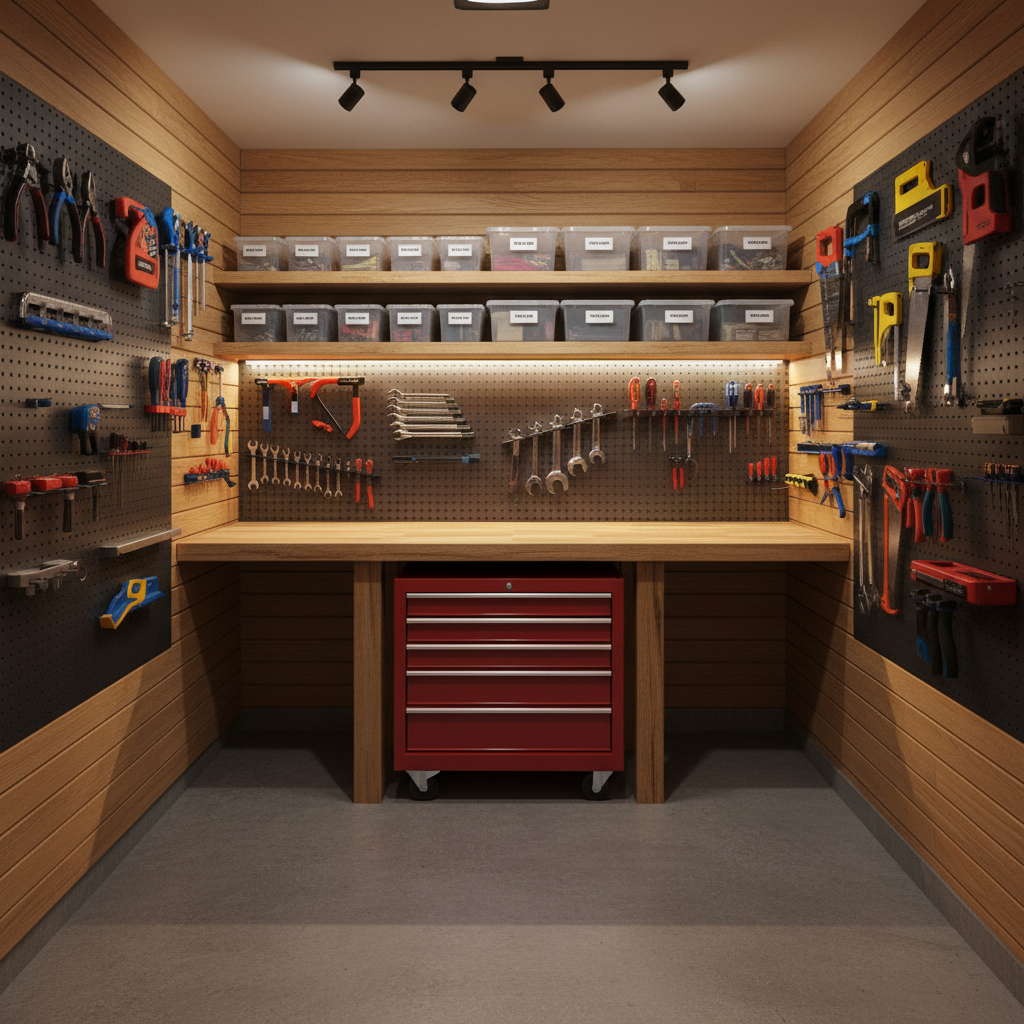Ever walked into your small garage, tripped over a hammer, and spent 15 minutes hunting for that elusive screwdriver? You’re not alone. A small garage can quickly become a chaotic black hole for tools, making even simple DIY tasks feel like an archaeological dig. But what if I told you that transforming your compact space into an organized, efficient, and even enjoyable workspace is not just a dream, but a totally achievable reality?
Trust me, I’ve been there. My first garage was barely bigger than a garden shed, and for years, it was a source of constant frustration. Tools were stacked precariously, important items disappeared into forgotten corners, and finding anything was a monumental task. But through trial and error, a lot of research, and a commitment to practical solutions, I learned that size doesn’t have to limit functionality. With smart strategies and a little creativity, you can maximize every inch and make your tools work for you, not against you.
This guide isn’t about buying a whole new garage; it’s about optimizing what you already have. We’ll dive into proven methods, from clever wall solutions to maintaining order, all designed to help you create an efficient, stress-free zone in your small garage. Let’s get that workspace whipped into shape!
The First Step: Declutter and Assess Your Arsenal
Before you even think about buying a single shelf or hook, you need to know what you’re working with. This initial purge is arguably the most critical step. Imagine trying to organize a messy desk without first deciding what papers you actually need to keep!
- Empty It Out (If Possible): If your garage is small enough, try to pull everything out into the driveway or yard. This might seem daunting, but it gives you a clear canvas and helps you visualize the space.
- The “Keep, Donate/Sell, Trash” Rule: Go through every single item. Be ruthless.
- Keep: Tools you use regularly, tools you need for specific projects, or valuable items.
- Donate/Sell: Tools you haven’t touched in years, duplicates, or items in good condition that you no longer need. Someone else can benefit!
- Trash: Broken tools, rusty bits beyond repair, empty containers, or actual garbage. Don’t let sentimentality keep junk in your space.
- Assess Frequency of Use: As you sort, mentally (or physically) group items by how often you use them. This will be crucial when deciding prime storage locations. Frequently used tools should be most accessible.
This process is more than just cleaning; it’s about understanding your needs and letting go of the excess. You’ll be amazed at how much “stuff” you accumulate that you neither need nor use.
Go Vertical: Embrace the Walls and Ceilings
In a small garage, floor space is a luxury you simply caot afford to waste. The golden rule of small space organization is simple: look up! Your walls and even your ceiling are prime real estate just waiting to be utilized.
Pegboards and Slatwall Systems
These are absolute game-changers for tool organization. I personally swear by a good pegboard system. They offer incredible flexibility:
- Versatility: You can hang almost anything – wrenches, screwdrivers, hammers, small power tools, measuring tapes, and even small bins for screws and nails.
- Customization: Hooks, shelves, and bins can be rearranged endlessly as your tool collection or needs change.
- Visibility: Everything is out in the open, making it easy to see and grab exactly what you need. No more rummaging through drawers!
- Installation: Fairly straightforward to install, transforming a blank wall into an active storage zone.
Slatwall systems offer a similar, often more robust, solution with a cleaner aesthetic, using specialized panels and accessories that slide into grooves.
Wall-Mounted Cabinets and Shelves
For items you don’t use every day, or for things you want to keep dust-free or out of sight, wall-mounted solutions are fantastic:
- Enclosed Cabinets: Perfect for paints, chemicals, less frequently used power tools, or anything that benefits from being stored securely and neatly. They provide a clean, uncluttered look.
- Open Shelving: Ideal for larger items like spare lumber, paint cans, or storage bins. Just make sure to keep them organized, or they can quickly look messy. Consider clear, labeled bins on these shelves.
Magnetic Tool Holders
This is one of my favorite simple hacks. A strong magnetic strip mounted near your workbench can be a lifesaver for small metal tools like screwdrivers, wrenches, pliers, and drill bits. They’re always visible, always within reach, and they free up precious drawer space. It’s an inexpensive solution with huge returns in efficiency.
Overhead Storage Racks
Don’t forget the ceiling! Heavy-duty overhead racks are perfect for storing seasonal items like camping gear, car top carriers, extra tires, or lengths of lumber. Ensure they are properly installed and can handle the weight, and use them for items you don’t need to access constantly. This frees up significant floor and wall space below.
Smart Storage Solutions: Beyond the Walls
While walls are crucial, there are other clever ways to organize your tools, even in the tightest of spaces.
Rolling Toolboxes and Carts
Mobility is key in a small garage. A good rolling toolbox or tool cart can be your best friend:
- Portability: You can roll your tools directly to your project, whether it’s working on the car or a small woodworking task.
- Compactness: Wheot in use, it can be tucked away into a corner or under a workbench, reclaiming valuable floor space.
- Integrated Storage: Many come with multiple drawers, compartments, and even a top work surface, making them a mini-workshop on wheels.
I often use my rolling cart as an extension of my workbench, keeping my most-used hand tools right where I need them.
Drawer Dividers and Organizers
If you have any drawers in your workbench or rolling toolbox, don’t just dump tools in them. Invest in drawer dividers, foam inserts, or pre-made plastic trays. This keeps sockets, wrenches, screws, and other small items neatly separated and prevents them from becoming a tangled mess. It’s amazing how much more you can fit into a drawer when things aren’t just rattling around!
Clear Bins and Containers
For screws, nails, bolts, washers, and other small parts, clear, stackable bins are invaluable. You can see what’s inside at a glance, eliminating the need to open every container. Labeling them clearly with a permanent marker or label maker is also a must. These can sit on shelves, within cabinets, or even on a workbench.
Corner Shelving Units
Corners are often overlooked and underutilized spaces. A corner shelving unit can effectively fill these awkward areas, providing extra storage for buckets, paint cans, or other bulkier items that don’t fit neatly elsewhere.
Categorize and Conquer: A Place for Everything
Once you have your storage systems in place, the next crucial step is to organize your tools logically. The “where does this go?” dilemma is the enemy of efficiency.
- Group Similar Tools: Keep all your plumbing tools together, all your electrical tools together, all your woodworking tools together, and so on. This makes it intuitive to find what you need for a specific task.
- “Shadow Boards”: If you’re using a pegboard, consider drawing or outlining the shape of each tool directly onto the board. This creates a “shadow” that tells you exactly where each tool belongs and instantly highlights when a tool is missing. It’s a professional touch that really helps maintain order.
- Label Everything: This can’t be stressed enough. Label shelves, bins, drawers, and even sections of your pegboard. Clear, consistent labeling saves you countless minutes of searching.
Once everything has a logical “home,” putting it away becomes second nature, and finding it is a breeze.
Maintain the Order: Habits for a Tidy Garage
Organization isn’t a one-time event; it’s an ongoing commitment. The best system in the world will fall apart if you don’t develop good habits.
- Put Tools Back Immediately: This is the golden rule. After you finish using a tool, put it back in its designated spot right away. Don’t leave it on the workbench or floor “just for a minute.” Those minutes turn into hours, and hours turn into clutter.
- Quick Tidy-Up After Each Project: Before you leave the garage, take an extra five minutes to sweep up debris, put away any stray items, and wipe down your workbench.
- Regular Mini-Decluttering Sessions: Once every few months, do a quick pass through your garage. Are there tools you haven’t used? Items that have migrated? A brief check-in prevents major clean-ups down the line.
- Involve Everyone: If others use the garage, make sure they understand the system and adhere to the “put it back” rule. Consistency is key.
It takes a conscious effort at first, but these habits will quickly become second nature, ensuring your small garage remains an efficient and pleasant workspace.
Conclusion: Your Efficient, Organized Small Garage Awaits!
Transforming a small, cluttered garage into an organized, efficient workspace might seem like a monumental task, but by breaking it down into manageable steps, it’s entirely achievable. We’ve covered everything from the crucial initial decluttering, to maximizing your vertical space with pegboards and shelves, implementing smart storage solutions like rolling carts, categorizing your tools logically, and finally, establishing good habits to maintain that hard-earned order.
Remember, the goal isn’t just a tidy garage; it’s a more productive, less stressful, and safer environment for all your projects. No more tripping hazards, no more wasted time searching, just seamless access to every tool you need. Start small, tackle one section at a time, and don’t be afraid to experiment with what works best for your specific tools and space. Your future self, calmly grabbing the right wrench on the first try, will thank you!




